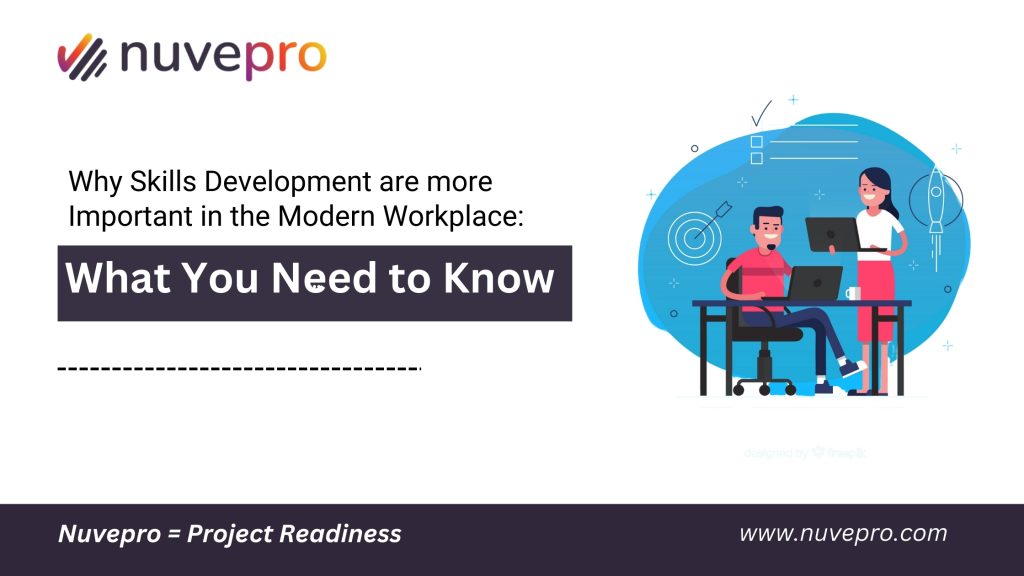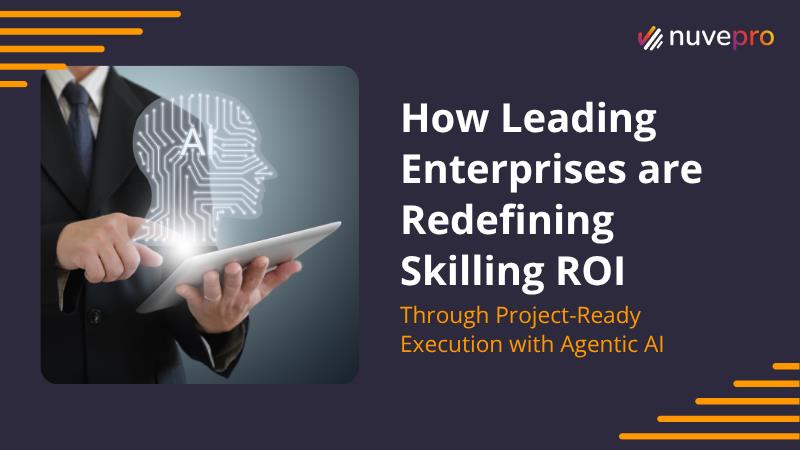The modern workplace is evolving faster than ever. Technology advancements, shifting business models, and the growing need for digital transformation have created a demand for a skilled workforce that can adapt and thrive. In this landscape, skills development isn’t just an added advantage—it’s a necessity.
Organizations that invest in workforce development are the ones that stay ahead. Individuals who focus on upskilling and reskilling open new career doors and ensure long-term employability. But what exactly makes skills development so critical today? Let’s break it down.
Understanding Work Skills Training: What Is It?
On the job training/ Work skill training is the foundation for a productive, adaptable, and successful workforce in a constantly evolving business landscape. A strong blend of hard and soft skills ensures that employees meet organizational demands, foster collaboration, and achieve career advancement.
As the labor market expands, the need for skilled employees becomes critical. On the job training is essential in equipping workforce with the latest knowledge and competencies required for their professions. This hands on training covers a range of skills, from hard skills like technical expertise to soft skills like problem-solving and communication.
The value of workforce training in work skills cannot be overstated. Employees must continuously adapt and acquire new skills to remain competitive and valuable to their organizations. Job skill training ensures that workforce stay updated on the latest technologies and workplace trends, enhancing efficiency and innovation.
In today’s fast-paced world, the demand for skilled professionals is higher than ever. Organizations are constantly looking for individuals who can adapt, innovate, and contribute to business growth. This is where work skills training plays a crucial role—it helps individuals stay relevant in their careers and ensures businesses remain competitive.
At Nuvepro, we believe Project Readiness is the key to professional success —equipping professionals with the right skills through hands-on learning to ensure they can contribute effectively from day one. But what exactly is workforce skills training, and why is it so important? Let’s dive in.
Why is Work Skills Training essential?
Imagine this: You hire a new employee, and they have an impressive resume. But when they start working, they struggle to use the company’s tools and software. The result? Delayed projects, productivity loss, and frustration.
This is why work skills training is essential. It bridges the gap between theoretical knowledge and real-world application, ensuring that employees are job-ready from day one.
Why Should Organizations Invest in Workforce Skills Training?
✅ Boosts productivity – Employees with the right skills can complete tasks faster and more efficiently.
✅ Reduces onboarding time – New hires get up to speed quickly, minimizing the learning curve.
✅ Enhances employee engagement – Learning new skills keeps employees motivated and confident.
✅ Future-proofs the workforce – Training helps employees stay relevant in a rapidly changing market.
But what exactly should companies and individuals focus on when it comes to skill training? Let’s explore.
What Are the Essential Skills for Today’s Workforce?
Every industry has its own unique skill requirements, but some abilities are universally valuable in today’s job market.
| Skill Type | Examples | Why It Matters |
| Technical Skills | Coding, data analysis, cloud computing | Helps in executing tasks efficiently |
| Soft Skills | Communication, teamwork, problem-solving | Crucial for collaboration and leadership |
| Project Readiness | Hands-on experience, real-world scenario training | Ensures employees can contribute from day one |
| Digital Literacy | Working with software, cybersecurity awareness | Essential in a tech-driven world |
| Adaptability | Learning new skills, embracing change | Helps employees stay competitive in evolving industries |
Think about your current skill set. Which of these skills do you already have, and which ones do you need to develop? Identifying skill gaps is the first step to building a strong career foundation.
How to Identify Training Needs?
Organizations and individuals must regularly assess skills to determine what training is necessary. Here’s how:
- Skill Assessments – Use online tools or company evaluations to understand current skill levels.
- Industry Trends Analysis – Stay updated with market demands and technological advancements.
- Feedback Mechanisms – Employees can request training based on their challenges.
- Project Readiness Index – Companies can track how prepared employees are for real-world tasks.
At Nuvepro, we help companies identify skill gaps and offer hands-on learning solutions to ensure employees are trained on real-world applications, making them project ready.
How Nuvepro Enables Project Readiness Through Hands-on Learning
At Nuvepro, we believe that learning by doing is the best way to build skills. Our hands on sandbox environments and challenge labs provide real-world training that prepares professionals for their jobs effectively.
What Makes Nuvepro’s Training Approach Unique?
✅ Real-World Simulations – Employees work on actual projects, not just theoretical concepts.
✅ Cloud-Based Sandboxes – No setup required, learners practice in a real-world cloud environment.
✅ Skill-Based Challenges – Gamified learning ensures engagement and retention.
✅ Immediate Application – Employees apply their skills in real-time projects.
Imagine learning cloud computing by deploying real applications instead of just watching videos. That’s the power of Nuvepro’s hands-on training.
Customizing Work Skills Training for Maximum Impact
Every organization has different goals, and a one-size-fits-all approach to training doesn’t work. Here’s how companies can tailor their training programs:
- Align Training with Business Goals – Identify the skills that directly contribute to company objectives.
- Personalized Learning Paths – Offer customized training modules based on employees’ roles.
- Flexible Learning Modes – Use a mix of online courses, live projects, and hands-on labs.
- Continuous Learning Culture – Encourage employees to keep upgrading their skills.
At Nuvepro, we help organizations create customized hands-on learning experiences to ensure maximum effectiveness.
Work Skills Training and Career Advancement: Taking Your Career to the Next Level
If you want to grow in your career, improving your skills is non-negotiable. Whether you’re looking for a promotion, a new job, or a career switch, skill development plays a crucial role.
How Can Work Skills Training Help Your Career?
✅ Gains technical expertise – Stay ahead in your field with industry-relevant skills.
✅ Improves soft skills – Leadership, communication, and teamwork are essential for growth.
✅ Enhances job security – Skilled professionals are in higher demand.
✅ Increases confidence – Knowing you have the right skills boosts self-assurance.
Think about where you see yourself five years from now. What skills do you need to reach that goal? Start building them today!
Skill Validation & Performance Tracking in Work Skills Training
Recognizing and validating skills is crucial in modern workforce development. Instead of traditional certifications, organizations now focus on real-world performance tracking to measure expertise.
Why Skill Validation Matters
✅ Real-World Application – Employers can assess skills based on practical performance, not just theoretical knowledge.
✅ Career Growth – Helps professionals demonstrate hands-on expertise to stand out in job applications.
✅ Continuous Learning – Encourages learners to track their progress and improve based on real-time feedback.
Nuvepro integrates hands-on skill assessments and project-based evaluations into its learning programs, ensuring that professionals gain verifiable, job-ready skills that truly matter in the workplace.
Training vs. Development: What’s the Difference?
People often confuse training with development, but they serve different purposes.
| Aspect | Training | Development |
| Focus | Immediate job skills | Long-term career growth |
| Objective | Improve performance in the current role | Prepare employees for future opportunities |
| Example | Learning how to use a new software tool | Developing leadership skills |
Both are essential for workforce skill development, ensuring employees succeed in their roles today while preparing for tomorrow.
Where to Start? Steps to Build Work Skills
1️. Set Career Goals – Identify where you want to be in the next few years.
2️. Identify Skill Gaps – Use skill assessments to find areas for improvement.
3️. Choose the Right Training – Pick courses, hands-on labs, or mentorship programs.
4️. Gain Certifications – Earn digital badges and certifications to validate your skills.
5️. Practice in Real Scenarios – Apply what you’ve learned through hands-on experience.
What’s one skill you want to improve today?
How Nuvepro Is Enabling Workforce Development
At Nuvepro, we believe that project readiness is the key to professional success. Traditional training methods often leave employees with knowledge but no practical experience. Our hands-on learning approach bridges this gap by providing real-world hands on sandbox environments, challenge labs, and upskilling platforms that focus on skill application.
Here’s how Nuvepro is making a difference:
1. Hands-On Learning Through Playgrounds
Instead of passive learning, Nuvepro offers cloud-based playground labs where learners can experiment with tools and technologies in real-time. This boosts their confidence and prepares them for actual project execution.
2. Customizable Training for Workforce Development
Every organization has unique training needs. Nuvepro tailors hands-on training programs to match an enterprise’s requirements, ensuring employees develop job-relevant skills.
3. Project Readiness for Faster Onboarding
New hires often struggle with transitioning from academia to corporate work. Nuvepro’s skill-based training ensures that freshers and lateral hires can contribute productively from day one.
4. Continuous Skill Assessment
Learning doesn’t stop at training. Nuvepro provides skill assessments to validate skills, making it easier for employers to recognize talent.
Workforce Development: The Key to Future Success
For both individuals and businesses, skills development is no longer optional—it’s essential for growth and sustainability. Whether it’s upskilling employees, preparing new hires, or adapting to new technologies, investing in workforce development ensures long-term success.
What Can You Do Next?
- If you’re an employee, identify skill gaps and invest in continuous learning.
- If you’re an organization, integrate hands-on training to enhance workforce capabilities.
- If you’re an educator, incorporate real-world applications in your curriculum to prepare students for the job market.
At Nuvepro, our motto is simple: Project Readiness. With hands-on learning, tailored training programs, and skill-based assessments, we empower individuals and organizations to stay ahead in the modern workforce. Are you ready to skill up for the future? Let’s get started!




